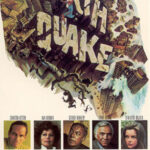Playback is a horror film that crams in all the current popular subgenres, namely dead teenagers, technology, demonic possession, and found footage, with just a hint of historical fiction thrown in for good measure. Perhaps it’s precisely because of this mash-up that the film never seems to know what it’s about. Structurally, all one can glean from this film is an idea that was never completely brought to fruition; we muddle our way through scenes that strain mightily to connect to one another via a back story, but somehow the harder it tries, the less sense it ultimately makes. Thematically, there’s nothing more or less at work than an excuse for gore, violence, death, and even a moment or two of nudity. Some audiences live for this kind of filmmaking. I’m not one of them.
The story begins in 1994 in what I suspect is somewhere in the Midwest. Through a combination of an omniscient camera and handheld footage, we watch as a teenager named Harlan Diehl (Luke Bonczyk) wanders through his house in the middle of the night holding a camcorder. His parents have already been murdered; we see their slashed bodies in various rooms of the house. His sister (Jana Veldheer) is bloody but alive, crawling on the floor, frantically screaming at Harlan to not hurt her baby, who lies innocently in a crib in an upstairs bedroom. Harlan sets up the camera in front of the baby before going down to the basement and activating his makeshift editing center, where a TV set shows live footage of the baby’s room. But before anything can happen, the police arrive, and everyone but the baby is dead.
Flash forward fifteen years. A high school student named Julian (Johnny Pacar) is taking a journalism class, in which the current assignment is to rediscover forgotten chapters of local history. He chooses the Harlan Diehl case. He recruits his project partner, Riley (Ambyr Childers), and his three friends as actors for a video reenactment of the murder scene. Ostensibly, this is because it gives him the perfect opportunity to indulge in his real passion, filmmaking, and produce a gory slasher film. All the necessary recording equipment is loaned to him by Quinn (Toby Hemingway), a teen who works at the local news station cataloging cassettes all day long. He’s one of those creepy kids that wears all black, resists long-winded conversations, avoids most people, and gets high by sniffing a rag soaked with what I think is paint thinner.
Julian asks Quinn if he could hook him up with news tapes related to the Harlan Diehl murders. Quinn locates a cassette, inserts it into the station’s VCR, and sees raw footage of Diehl’s body being wheeled by stretcher into an ambulance. But it seems he wasn’t dead just yet; he lunges at the camera and screams, at which point we see split-second intercut images of static and what appears to be an old photograph. Quinn is knocked out of his chair. The logistics are a little fuzzy, but it seems Diehl passed something into the camera, which then imprinted itself on the tape, which was then unleashed into Quinn’s body when he inserted the tape into VCR and hit play. As the film progresses, his body will deteriorate. No reason is given for this, but then again, I guess one isn’t needed.
And from here, the story gets increasingly silly and perplexing. We learn (in a hilariously convenient scene of exposition) about a nineteenth century French man named Louis Le Prince, supposedly the real father of cinema, and about how he captured footage of his family. Each member was murdered shortly thereafter because, supposedly, Le Prince was possessed. Of course, if all his family was murdered, then there would be no way for there to be a bloodline, which factors prominently into the present-day portions of the story. Anyway, Julian and Riley are determined to dig deeper into the story and figure out the identity of Diehl baby, who no one seems to know anything about. Julian’s mother (Dorien Davies) urges him to not pursue this any further, although she doesn’t want to tell him why.
As horrendous as I found the plot and the characters, who are essentially disposable teenage typecasts, two specific elements of Playback do the most damage. One is a completely unnecessary subplot starring Christian Slater as a perverted cop who pays Quinn to set up spy cameras in the girls’ locker room and in the bedrooms of two of Julian’s friends, who are hot sisters. The other is a plot twist manhandled by the filmmakers into an indecipherable mess. Part of the problem is that, even though no real effort is made to hide it, no one bothers to confirm or deny what the audience already knows. The rest of it just doesn’t make sense, given the characters involved and their relationship to one another. And is it just me, or is there far too much transferring of evil from TV screen to camera to body, along with victims staring helplessly at camera lenses? Perhaps the real lesson here is, quite simply, to look away.
(www.atatheaternearyou.net)




